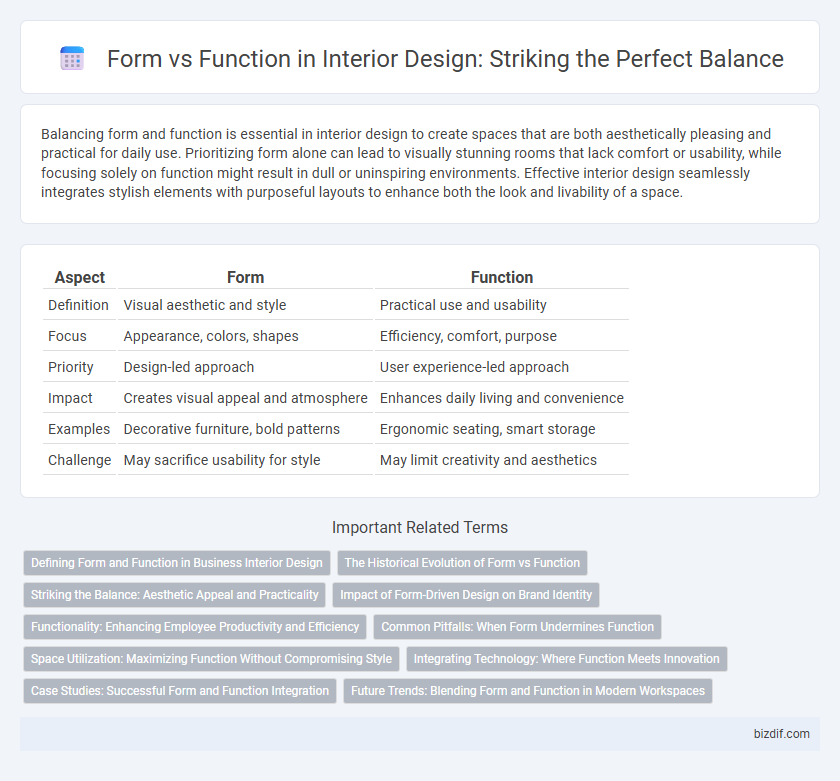Balancing form and function is essential in interior design to create spaces that are both aesthetically pleasing and practical for daily use. Prioritizing form alone can lead to visually stunning rooms that lack comfort or usability, while focusing solely on function might result in dull or uninspiring environments. Effective interior design seamlessly integrates stylish elements with purposeful layouts to enhance both the look and livability of a space.
Table of Comparison
| Aspect | Form | Function |
|---|---|---|
| Definition | Visual aesthetic and style | Practical use and usability |
| Focus | Appearance, colors, shapes | Efficiency, comfort, purpose |
| Priority | Design-led approach | User experience-led approach |
| Impact | Creates visual appeal and atmosphere | Enhances daily living and convenience |
| Examples | Decorative furniture, bold patterns | Ergonomic seating, smart storage |
| Challenge | May sacrifice usability for style | May limit creativity and aesthetics |
Defining Form and Function in Business Interior Design
In business interior design, form refers to the aesthetic elements such as shapes, colors, and textures that create a visual identity aligned with brand image. Function encompasses the practical aspects, including spatial layout, ergonomics, and workflow efficiency that enhance employee productivity and customer experience. Balancing form and function ensures that commercial spaces are both visually appealing and operationally effective.
The Historical Evolution of Form vs Function
The historical evolution of form versus function in interior design reveals a shift from ornate, heavily decorated spaces of the Baroque and Rococo periods to the minimalist, utility-driven aesthetics of the Bauhaus and Modernism movements. In the early 20th century, designers like Le Corbusier emphasized function as the core principle, promoting simple, clean lines and materials that serve practical purposes. This transformation underscored a broader cultural move towards efficiency and usability, balancing aesthetic appeal with everyday practicality in contemporary interior spaces.
Striking the Balance: Aesthetic Appeal and Practicality
Striking the balance between form and function in interior design ensures spaces are visually captivating while meeting daily practical needs. Prioritizing ergonomic layouts and durable materials enhances usability without compromising style, creating environments that are both inviting and efficient. Designers achieve harmony by integrating aesthetic elements like color and texture with functional aspects such as lighting and storage solutions.
Impact of Form-Driven Design on Brand Identity
Form-driven design significantly enhances brand identity by creating visually striking spaces that resonate emotionally with clients. Prioritizing aesthetic appeal over mere functionality allows brands to communicate their core values and personality more effectively through distinctive shapes, colors, and materials. This approach fosters memorable experiences, solidifying brand recognition and loyalty in competitive markets.
Functionality: Enhancing Employee Productivity and Efficiency
Functionality in interior design directly influences employee productivity and efficiency by creating ergonomic workspaces that reduce physical strain and support natural movement. Strategic layout planning optimizes space utilization, facilitating smooth workflow and minimizing distractions. Incorporating adjustable furniture and adequate lighting further enhances comfort, enabling sustained focus and performance throughout the workday.
Common Pitfalls: When Form Undermines Function
Prioritizing form over function often leads to impractical interior spaces that sacrifice usability for aesthetics, such as stylish furniture that is uncomfortable or decorative elements that obstruct natural flow. Common pitfalls include visually striking designs that ignore ergonomic principles, causing daily inconvenience and reduced comfort. Designers must balance artistic vision with functional needs to create interiors that are both beautiful and livable.
Space Utilization: Maximizing Function Without Compromising Style
Effective space utilization in interior design balances form and function by creating environments that are both aesthetically pleasing and highly practical. Incorporating multi-functional furniture and strategic storage solutions optimizes available space while maintaining a stylish ambiance. Designs that prioritize ergonomic layouts ensure maximum usability without sacrificing visual appeal, enhancing comfort and efficiency in any room.
Integrating Technology: Where Function Meets Innovation
Integrating technology in interior design transforms spaces by seamlessly combining form with function, enhancing both aesthetic appeal and usability. Smart home systems and innovative materials enable environments to adapt dynamically to users' needs, promoting efficiency and comfort. Prioritizing intuitive interfaces and sleek designs ensures technology complements the overall style without compromising functionality.
Case Studies: Successful Form and Function Integration
Case studies from renowned interior design projects reveal that seamless integration of form and function enhances both aesthetic appeal and user experience. Notable examples like the Eames House and Samsung's T1 Office showcase innovative spatial planning combined with ergonomic design principles. These projects underscore the importance of balancing artistic vision with practical utility to create harmonious living and working environments.
Future Trends: Blending Form and Function in Modern Workspaces
Future trends in interior design emphasize the seamless integration of form and function to create innovative modern workspaces that enhance productivity and aesthetic appeal. Adaptive layouts featuring ergonomic furniture, smart lighting systems, and multifunctional elements reflect a shift towards environments that support wellness and technology-driven collaboration. Sustainable materials and biophilic design principles further bridge the gap between visual elegance and practical utility in contemporary office interiors.
Form vs Function Infographic

 bizdif.com
bizdif.com